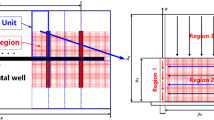Abstract
In order to increase the production of oil in low permeability reservoirs with high efficiency, it is necessary to fully understand the properties and special behaviors of the reservoirs and correctly describe the flow in the reservoirs. This paper applies the branching network mode to the study of the starting pressure gradient of nonlinear Newtonian fluid (Bingham fluid) in the reservoirs with low permeability based on the fact that the fractured network may exist in the reservoirs. The proposed model for starting pressure gradient is a function of yield stress, microstructural parameters of the network. The proposed model may have the potential in further exploiting the mechanisms of flow in porous media with fractured network.
Similar content being viewed by others
References
Lorente S, Wechsatol W, Bejan A. Tree-shaped flow structures designed by minimizing path lengths. Int J Heat Mass Transf, 2002, 45: 3299–3312
Bear J. Dynamics of Fluids in Porous Media. NewYork: Elsevier, 1972
Barenblatt G E, Entov B M, Rizhik B M. Flow of Liquids and Gases in Natural Formations. Moscow: Nedra, 1984
Vradis G C, Dougher J, Kumar S. Entrance pipe flow and heat transfer for a Bingham plastic. Int J Heat Mass Transf, 1993, 36(3): 543–552
Hammad K J, Vradis G C. Creeping flow of a Bingham plastic through axisymmetric sudden contractions with viscous dissipation. Int J Heat Mass Transf, 1996, 39(8): 1555–1567
Nascimento U C S, Macêdo E N, Quaresma J N N. Thermal entry region analysis through the finite integral transform technique in laminar flow of Bingham fluids within concentric annular ducts. Int J Heat Mass Transf, 2002, 45(4): 923–929
Khatyr R, Ouldhadda D, Idrissi A II. Viscous dissipation effects on the asymptotic behaviour of laminar forced convection for Bingham plastics in circular ducts. Int J Heat Mass Transf, 2003, 46: 589–598
Blackery J, Mitsoulis E. Creeping motion of a sphere in tubes filled with a Bingham plastic material. J Non-Newtonian Fluid Mech, 1997, 70: 59–77
Roquet N, Saramito P. An adaptive finite element method for Bingham fluid flows around a cylinder. Comput Methods Appl Mech Eng, 2003, 192(31): 3317–3341
Balhoff M T, Thompson K E. Modeling the steady flow of yieldstress fluids in packed beds. AICHE J, 2004, 50(12): 3034–3048
Prada A, Civan F. Modification of Darcy’s law for the threshold pressure gradient. J Pet Sci Eng, 1999, 22(4): 237–240
ΓорщуноВ A T. 1987. The Development of the Singular Oil Field (in Chinese). Translated by Zhang S B. Beijing: Petroleum Industry Press, 1987. 18–184
Li F H, Liu, C Q. Pressure transient analysis for unsteady porous flow with start-up pressure derivative (in Chinese). Well Testing, 1997, 6(1): 1–4
Mu X Y, Liu Y X. Study of starting pressure gradient in low-peameability oilfield (in Chinese). Oil & Gas Recov Technol, 2001, 8(5): 58–60
Liu Y W, Ding Z H, He F Z. Three kinds of methods for determining the start-up pressure gradients in low permeability reservoir (in Chinese). Well Testing, 2002, 11(4): 1–4
Song F Q, Liu C Q, Li F H. Transient pressure of percolation through one dimension porous media with threshold pressure gradient (in Chinese). Appl Math Mech, 1999, 20(1): 25–32
Mandelbrot B B. The Fractal Geometry of Nature. New York: Freeman, 1982
Zamir M. Arterial branching within the confines of fractal L-System formalism. J Gen Physiol, 2001, 118: 267–275
Uylings H B M. Optimization of diameters and bifurcation angles in lung and vascular tree structures. Bull Math Biol, 1977, 39: 509–519
Bejan A, Rocha L A O, Lorete S. Thermodynamic optimization of geometry: T- and Y-shaped constructs of fluid streams. Int J Therm Sci, 2000, 39: 949–960
Acuna J A, Ershagghi I, Yortsos Y C. Practical application of fractal pressure transient analysis of naturally fractured reservoir. SPEFE, 1995, 10(3): 173–179
Tian J, Tong D K. The flow analysis of fluids in fractal reservoir with the fractional derivative. J Hydrodyn, 2006, 18(3): 287–293
Scherdegger A E. The Physics of Flow in Porous Media. New York: Elsevier, 1972
Author information
Authors and Affiliations
Corresponding author
Rights and permissions
About this article
Cite this article
Li, Y., Yu, B. Study of the starting pressure gradient in branching network. Sci. China Technol. Sci. 53, 2397–2403 (2010). https://doi.org/10.1007/s11431-010-4068-3
Received:
Accepted:
Published:
Issue Date:
DOI: https://doi.org/10.1007/s11431-010-4068-3




